Chimpanzee Trekking in Kibale involves going deep inside Africa’s jungles in search of man’s closest relatives. Kibale forest National Park is arguably the best place to spot wild chimpanzees in Africa. The forest is located in the western part of the Uganda and at the edge of the East African Rift Valley. The forest is close to the Rwenzori Ranges of mountains, Queen Elizabeth national park and Semuliki National park. Overall, Kibale National Park covers an area of 296 square miles and is home to 13 different species of primates. It is for this reason that the park is often referred to as “primate’s capital of the world”.
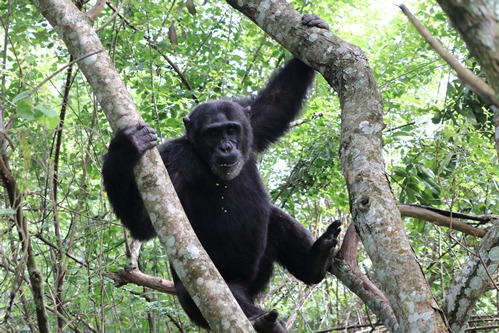 Kibale forest national park was established in 1993 to stop illegal logging and protect wildlife. Apart from primates, Kibale National Park is also home to about 70 species of mammal, 375 of birds and 200 of trees. Chimpanzees are the key attractions in the park and over 1500 individuals call the forest home. Chimpanzees are considered endangered and have been included in the red list of the International Union for Conservation of Nature (IUCN). Chimpanzees are our closest relatives – even more than orangutans and gorillas. They are tailless primates with a high level of intelligence. They live in tropical rain-forests of East, West and Central Africa. A few can also be sighted in East Asia.
Kibale forest national park was established in 1993 to stop illegal logging and protect wildlife. Apart from primates, Kibale National Park is also home to about 70 species of mammal, 375 of birds and 200 of trees. Chimpanzees are the key attractions in the park and over 1500 individuals call the forest home. Chimpanzees are considered endangered and have been included in the red list of the International Union for Conservation of Nature (IUCN). Chimpanzees are our closest relatives – even more than orangutans and gorillas. They are tailless primates with a high level of intelligence. They live in tropical rain-forests of East, West and Central Africa. A few can also be sighted in East Asia.
Chimps are social animals and live in communities of between 15 to 1000 individuals led by a dominant male. They feed on shoots, fruits, leaf buds, blossoms, birds, small insects and will hunt smaller primates or antelope for meat. Because of their high intelligence, chimpanzees are capable of using tools to gather fruits or remove insects hidden inside trees or small ground holes. They are capable of showing compassion to one another and will take care of an ailing member of the group. If a member of the group dies, they show emotion and mourn. The average lifespan of a chimpanzee in the wild is about 15 years but some break the barrier and go to 25 years. While in captivity, chimps can live up to 60 years. One example was a famous chimp named Zakayo. Zakayo lived the Uganda Wildlife Education Centre (UWEC) in Entebbe and died at the age of 56.
Where else can you see Chimpanzees in Uganda? Apart from Kibale Forest National Park, chimpanzee trekking in Uganda can be done in Budongo forest of Murchison falls national park, Kyambura gorge in Queen Elizabeth national park, Kalinzu forest reserve, Bwindi Impenetrable forest and Toro-Semliki wildlife reserve. Chimpanzees are also found in smaller forests in Western Uganda, the Ngamba Island Chimpanzee Sanctuary and Entebbe zoo (Uganda Wildlife Education Centre).
Chimpanzee Trekking in Kibale Forest National Park
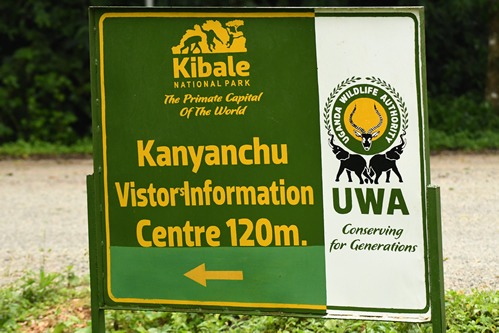 As we already mentioned earlier, Kibale forest has the highest number of chimpanzees in Uganda making it the best place to track chimpanzees. There are 4 communities/groups which are habituated. The high concentration of chimps in Kibale means the chances of seeing them are higher than anywhere else. Because of this high concentration of chips, Kibale forest is considered to be the best place to spot wild chimps in the world. To track chimpanzees in Kibale forest national park, a tourist must acquire a permit which goes for $200 per person. There are three chimpanzee tracking sessions in the park. One session begins early in the morning, another starts mid-morning and the final one later in the afternoon. At the time of booking the permit, a traveler must know their session/shift to avoid missing the activity.
As we already mentioned earlier, Kibale forest has the highest number of chimpanzees in Uganda making it the best place to track chimpanzees. There are 4 communities/groups which are habituated. The high concentration of chimps in Kibale means the chances of seeing them are higher than anywhere else. Because of this high concentration of chips, Kibale forest is considered to be the best place to spot wild chimps in the world. To track chimpanzees in Kibale forest national park, a tourist must acquire a permit which goes for $200 per person. There are three chimpanzee tracking sessions in the park. One session begins early in the morning, another starts mid-morning and the final one later in the afternoon. At the time of booking the permit, a traveler must know their session/shift to avoid missing the activity.
![]() The morning session starts at 8:00am, the mid-morning session at 10:30am and the afternoon session at 12:30am. Tourists are required to report at least 30 minutes before each session for the briefing at Kanyanchu (Park headquarters). The briefing covers the rules of chimpanzee tracking, what to park, the chimpanzee communities in the park and history of Kibale National Park. During the briefing, chimp permits will be verified. After the briefing, you will know which of the chimp communities you will be tracking. You will also be assigned a Park Ranger to lead you into the forest in search of the chimps.
The morning session starts at 8:00am, the mid-morning session at 10:30am and the afternoon session at 12:30am. Tourists are required to report at least 30 minutes before each session for the briefing at Kanyanchu (Park headquarters). The briefing covers the rules of chimpanzee tracking, what to park, the chimpanzee communities in the park and history of Kibale National Park. During the briefing, chimp permits will be verified. After the briefing, you will know which of the chimp communities you will be tracking. You will also be assigned a Park Ranger to lead you into the forest in search of the chimps.
![]() Chimpanzees are very vocal compared to gorillas and you can hear the group hooting from miles away. You will follow the direction of the hoots to find them. Unlike gorilla trekking, finding the chimps in Kibale is generally quicker. You may find them in only 30 minutes or an hour on a good day. That said, observing chimps is much more difficult. This is because they are very mobile and love spending time on tree tops. Gorillas weigh more and are less agile hence preferring to stay on the ground. This allows tourists to observe them very closely and take photos easily. Taking photos of chimpanzees requires more effort, time and you might be forced to keep following them to get the best shots.
Chimpanzees are very vocal compared to gorillas and you can hear the group hooting from miles away. You will follow the direction of the hoots to find them. Unlike gorilla trekking, finding the chimps in Kibale is generally quicker. You may find them in only 30 minutes or an hour on a good day. That said, observing chimps is much more difficult. This is because they are very mobile and love spending time on tree tops. Gorillas weigh more and are less agile hence preferring to stay on the ground. This allows tourists to observe them very closely and take photos easily. Taking photos of chimpanzees requires more effort, time and you might be forced to keep following them to get the best shots.
![]() When you find them settled in one place, prepare for a lot of drama and group dynamics which you don’t often see with gorillas. Chimps are very playful, love somersaulting and jumping from one tree canopy to another. At the sight of intruders, they will stop for a while to see if there is any danger. Once all is clear, they go back to feeding, playing or mating amidst a lot of noise. Though chimpanzees spend most of their time on trees, they offer a more interactive experience. Gorillas allow you to get closer to them but you can’t help but feel that you are an outsider. Gorillas allow you close to them but they act like you don’t exist.
When you find them settled in one place, prepare for a lot of drama and group dynamics which you don’t often see with gorillas. Chimps are very playful, love somersaulting and jumping from one tree canopy to another. At the sight of intruders, they will stop for a while to see if there is any danger. Once all is clear, they go back to feeding, playing or mating amidst a lot of noise. Though chimpanzees spend most of their time on trees, they offer a more interactive experience. Gorillas allow you to get closer to them but you can’t help but feel that you are an outsider. Gorillas allow you close to them but they act like you don’t exist.
Whereas tourists are allowed strictly one hour with gorillas, the Rangers may extend your time with chimps to get the best camera shots or to compensate for the constant movement of the primates. It is important to note that chimpanzee permits in Kibale National Park now costs $200 whereas gorilla permits go for $700 per person.
The Chimpanzee Habituation Experience in Kibale Forest National Park
The chimpanzee habituation experience allows tourists to visit a chimpanzee group which is still undergoing the habituation process. It is a more comprehensive experience which takes over 6 hours. By the end of the day, you would have interacted with senior researchers and some of the best trackers. You ![]() will learn almost everything there is to know about chimps including what is being done to protect them globally. The Chimpanzee habituation experience begins as early as 5:30am and may go on till late in the evening.
will learn almost everything there is to know about chimps including what is being done to protect them globally. The Chimpanzee habituation experience begins as early as 5:30am and may go on till late in the evening.
The activity begins earlier than usual in order to find the chimps still sleeping in their nest. Tourists will observe the chimps wake up from their nests and begin moving to find food. As they follow the primates, travelers will learn their methods of communication, the character of each individual in the group, their feeding pattern and how they make their nest. The chimpanzee habituation experience costs $250 per person. Because it lasts the entire day, participants should go out into the forest with packed lunch, a camera, binoculars and drinking water.
The Cost of Chimpanzee Trekking in Kibale National Park
The cost of chimpanzee trekking in Kibale forest includes the permits and other expenses like transport, accommodation and meals. Chimpanzee permits cost $200 for foreigners, $150 for foreign residents and ![]() 150,000 shillings for East African residents. The chimpanzee habituation permit goes for $250 per person. You will need at least 3 days for a meaningful chimp tracking tour. One day should be set aside for traveling to Kibale, the second for tracking the chimps and the third for getting back to the airport for departure or to the capital Kampala. A 3-day chimpanzee tour in Kibale will cost $850 per person for budget accommodation, $950 per person for mid-range accommodation and up to $1300 per person for the luxury accommodations. It is important to note that most tourists who go for chimpanzee trekking do so as part of an extensive tour of Uganda involving gorilla trekking in Bwindi forest, general wildlife and other activities.
150,000 shillings for East African residents. The chimpanzee habituation permit goes for $250 per person. You will need at least 3 days for a meaningful chimp tracking tour. One day should be set aside for traveling to Kibale, the second for tracking the chimps and the third for getting back to the airport for departure or to the capital Kampala. A 3-day chimpanzee tour in Kibale will cost $850 per person for budget accommodation, $950 per person for mid-range accommodation and up to $1300 per person for the luxury accommodations. It is important to note that most tourists who go for chimpanzee trekking do so as part of an extensive tour of Uganda involving gorilla trekking in Bwindi forest, general wildlife and other activities.
The best time to see chimps in Kibale National Park
Like most places along the equator, Kibale National Park experiences two rain and dry seasons. The best time to see chimpanzees in Kibale are during the dry months of December to mid-march and June to ![]() mid-October. This doesn’t imply that the other months are closed off to tourism. Chimpanzee trekking is open every day of the week and throughout the year including public holidays.
mid-October. This doesn’t imply that the other months are closed off to tourism. Chimpanzee trekking is open every day of the week and throughout the year including public holidays.
With global warming and the resultant climate change, the rains come at times when you don’t expect. We therefore encourage you not the ignore the other months because you may end up having the best experience and with less crowds. That said, tourists prefer visiting Uganda during the dry season because the trails leading to the chimpanzees are dry and passable.
Rules and regulations for chimpanzee Trekking in Kibale National Park
![]() The age limit for chimpanzee tracking in Kibale is 12 years and above. Below that, you are considered not yet mature enough for the activity. You can read about the rules for gorilla trekking to find out why children are restricted from tracking large primates.
The age limit for chimpanzee tracking in Kibale is 12 years and above. Below that, you are considered not yet mature enough for the activity. You can read about the rules for gorilla trekking to find out why children are restricted from tracking large primates.
A maximum of 6 people is allowed to track each community of chimps per session. This restriction is to avoid scaring the primates with large crowds and also to avoid spreading diseases.
A person with a contagious disease like flue, cold, covid-19 is not permitted to track chimpanzees. Remember that the primates are our greatest relatives and because of that are prone to human diseases.
Always follow instructions from the Park Rangers to avoid irritating the chimps or being attacked by one of them.
Packing List for chimpanzee Trekking in Kibale Forest
Shoes for hiking: Kibale is heavily forested. To navigate through the dense forests, one needs sturdy shoes which are waterproof and can cover the entire feet. With proper hiking shoes, a tracker is able to pass through muddy and slippery trails in the forest.
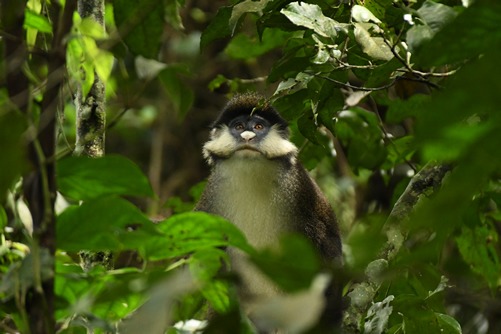 Jungle clothes: Not every cloth is designed to be worn on a safari trip. There are clothes which are designed to be used in the kind of conditions found in Kibale. The material must be water-resistant, light and covering the whole body. The colors must also not be too bright. It is important to also include a rain-jacket because Kibale lies in the equatorial region. The presence of forest means you can expect rain at any time of the year.
Jungle clothes: Not every cloth is designed to be worn on a safari trip. There are clothes which are designed to be used in the kind of conditions found in Kibale. The material must be water-resistant, light and covering the whole body. The colors must also not be too bright. It is important to also include a rain-jacket because Kibale lies in the equatorial region. The presence of forest means you can expect rain at any time of the year.
Camera and Binoculars: You cannot embark on a chimpanzee trekking safari without a good camera. How will you capture the beautiful moments with the primates? What proof will you have to show that you saw the primates? The camera must be of good quality and have the ability to take several photos in a second because chimps are very agile/mobile. You will need a pair of binoculars to observe the chimps once they go high up the trees.
A backpack: A light back-pack to carry important items like cameras, binoculars, toiletries, drinking water, snacks and spare clothes is required for chimpanzee trekking in Kibale.
Other Things To do in Kibale Forest National Park
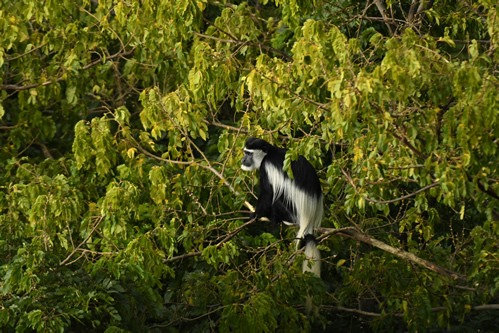 Tracking smaller primates: Kibale is referred to as the primate’s capital of the world for a reason. The park is home to 12 other species of primates including blue monkeys, grey cheeked mangabeys, black/white colobus, red-tailed monkeys, vevert monkeys, pottos monkeys and more. These primates can be seen during chimpanzee trekking or on a separate guided nature walk in the park.
Tracking smaller primates: Kibale is referred to as the primate’s capital of the world for a reason. The park is home to 12 other species of primates including blue monkeys, grey cheeked mangabeys, black/white colobus, red-tailed monkeys, vevert monkeys, pottos monkeys and more. These primates can be seen during chimpanzee trekking or on a separate guided nature walk in the park.
Nature walks: This is the second most popular activity in Kibale national park. With the help of a resident Guide, tourists can take a walk inside the vast forest in search of various species of animals and also to admire the scenery. Kibale Forest National Park is also home to elephants, buffaloes, ![]() bushbuck, duikers, giant forest hog and more. The best way to experience the remarkable biodiversity in the forest is to take a specially arranged nature walk.
bushbuck, duikers, giant forest hog and more. The best way to experience the remarkable biodiversity in the forest is to take a specially arranged nature walk.
Birding: Kibale forest national park is one of the top birding destinations in Uganda. Over 370 bird species have been recorded in the forest. On a birding expedition, tourists can expect to spot black/white casqued Hornbill, blue spotted wood doves, the western green tinker bird, little greenbul, blue-breasted Kingfishers, the great blue turaco and more.
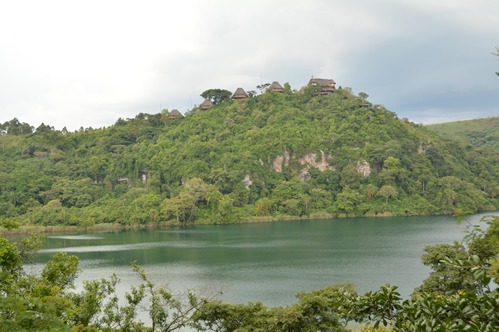 Tour around the Bigodi Wetland Sanctuary: This wetland is adjacent to Kibale forest national park and is home to over 120 species of birds. It also draws the parks primates. Exploring these wetlands ends with a tour of the local villages and also the local women’s project.
Tour around the Bigodi Wetland Sanctuary: This wetland is adjacent to Kibale forest national park and is home to over 120 species of birds. It also draws the parks primates. Exploring these wetlands ends with a tour of the local villages and also the local women’s project.
Visit the Crater Lakes: Kibale National Park lies on the fringes of the great East African Rift Valley. As a result, it is also home to amazing features left behind during the formation of the rift valley millions of years ago. Among the outstanding feature are the crater lakes like Kyaninga and Ambere. Visiting these crater lakes will help you appreciate the sheer wonders of nature and the natural beauty of Uganda.
Accommodation during chimpanzee Trekking in Kibale Forest National Park
Kibale National Park has got several accommodation options which offer budget, mid-range and luxury facilities. Some of them include: –
Primates Lodge: This is built close to the park offices. Travelers like to stay here due to its proximity to the starting point for chimpanzee tracking and the habituation experience. Primates lode is a large luxury facility with 16 spacious rooms. Each room is self-contained with flush toilets, bathrooms, living rooms, study desks and a balcony. The lodge area has wireless internet connectivity but there is also a bar and restaurant where one can go to for refreshments.
Crater Safari Lodge: This sensational eco-lodge is located 7 kilometers away from the park. If you are planning to arrange for a chimpanzee tour, then this lodge is one of the best places to consider. Crater Safari Lodge offers such a remarkable wilderness experience that you definitely won’t forget. Each of the 21 rooms has a balcony offering outstanding views of the crater lake. The lodge is equipped with a bar, swimming pool, restaurant and lounge area. In the evening, a campfire is set for residents to interact and share their experiences while in Uganda.
![]() Kyaninga Lodge: This luxury lodge is built overlooking one of the deepest crater lakes in Uganda. It has 9 fabulous private chalets which are all self-contained and offer the African wilderness experience. The chalets offer comfortable beds as well as verandas where one can see the Rwenzori mountain ranges from a distance. Bathrooms are first class with flowing water (both cold and hot). Kyaninga Lodge offers both international and local food which can be served at the main restaurant or through room service. Booze is available at the bar to light up your evenings after a long day of chimpanzee trekking.
Kyaninga Lodge: This luxury lodge is built overlooking one of the deepest crater lakes in Uganda. It has 9 fabulous private chalets which are all self-contained and offer the African wilderness experience. The chalets offer comfortable beds as well as verandas where one can see the Rwenzori mountain ranges from a distance. Bathrooms are first class with flowing water (both cold and hot). Kyaninga Lodge offers both international and local food which can be served at the main restaurant or through room service. Booze is available at the bar to light up your evenings after a long day of chimpanzee trekking.
Chimpanzee Forest Guest House: This one of the trendiest budget and mid-range lodges in Kibale National Park. The Guesthouse is built close to the visitors Centre of the Uganda Wildlife Authority. All rooms are all self-contained but there is also a large swimming pool for use during the heat of the day. Chimpanzee Forest Guesthouse offers beautiful views of the green tea plantations and forest.


